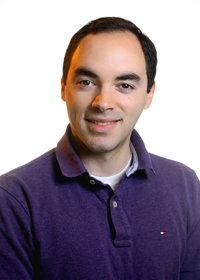
Sergio Pineda Flores
University of California, Berkeley
Sergio Pineda Flores decided to study computational chemistry because its techniques are useful in a range of fields, including physics, materials science and biochemistry. "I'm a jack of all trades at this point. I'm always interested in learning how different fields approach a problem,” says the Department of Energy National Nuclear Security Administration Stewardship Science Graduate Fellowship (DOE NNSA SSGF) recipient.
Science teachers at his Washington, D.C., high school seeded his broad interests. Even his cross-country running coach worked at the U.S. Naval Research Laboratory. After starting as a chemistry major at Haverford College, Pineda Flores got his first taste of computational chemistry research with Joshua Schrier, using density functional theory (DFT) to discover new materials.
After completing his degree in 2015, Pineda Flores worked for a year as a researcher at the DuPont chemical company in Wilmington, Delaware, before heading to the University of California, Berkeley. In his graduate studies with Eric Neuscamman, he focused on quantum Monte Carlo (QMC) methods, techniques that can improve the accuracy of molecular energy calculations while limiting computational demand. Pineda Flores implemented orbital optimization for QMC, a feature that lets researchers refine estimates of the probable space that excited-state electrons can occupy.
Improved calculations can help scientists better understand optical band gaps, supporting the search for new materials to harness solar energy and serve other uses. The techniques also can improve scientists’ insights into the materials’ physics.
Pineda Flores tested these techniques on manganese oxide and on iron oxide. The latter can act as a catalyst to split water in the presence of light for hydrogen fuel production. (That work was done during his 2019 practicum with Luke Shulenburger at Sandia National Laboratories in New Mexico.) QMC orbital optimization can improve band gap calculations, Pineda Flores says, but it’s still computationally expensive. So for now, the tool is most practical for a system in which researchers want to invest added computational resources for improved results.
At Sandia, Pineda Flores also worked on molecular dynamics simulations of lithium fluoride (LiF), calculating the dielectric constant of the material at a range of temperatures and pressures. LiF is used in windows that give diagnostic tools access to measure shock experiments, so researchers want to understand as much as possible about its behavior under extreme conditions.
His Sandia experiences convinced Pineda Flores to continue doing computational research at a national laboratory. In early 2020 he contacted Lawrence Livermore National Laboratory about openings, perhaps for 2021. He learned that the lab had an immediate opening fitting his interest in high-performance computing for the physical sciences. With Neuscamman’s support, Pineda Flores applied for the position and finished his degree ahead of schedule. He started work at Livermore in August 2020.


